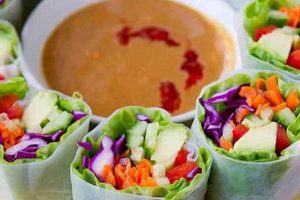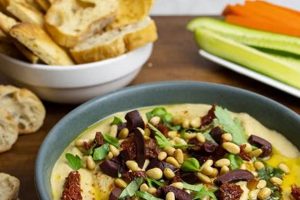Chilaquiles, a traditional Mexican dish, typically consists of lightly fried corn tortillas simmered in salsa and often topped with cheese, crema, and sometimes meat. The vegan adaptation of this dish replaces animal-based ingredients with plant-derived alternatives. For example, cashew cream can substitute for dairy-based crema, and plant-based cheeses or nutritional yeast can provide a cheesy flavor.
This adaptation offers several benefits. It allows individuals adhering to a plant-based diet to enjoy a culturally significant dish. It also aligns with health-conscious eating by reducing saturated fat and cholesterol intake. Furthermore, it promotes sustainability by reducing reliance on animal agriculture. The historical context of chilaquiles suggests resourcefulness and adaptation, making the vegan version a continuation of that tradition.
The versatility of the base recipe allows for various modifications. Subsequently, the following sections will explore specific ingredient substitutions, nutritional considerations, and preparation techniques related to creating a satisfying and authentic plant-based version of this Mexican classic.
Crafting Superior Vegan Chilaquiles
Achieving optimal flavor and texture in a plant-based rendition of chilaquiles requires careful attention to ingredient selection and preparation methods. The following tips offer guidance on how to elevate the dish to its fullest potential.
Tip 1: Tortilla Selection: Opt for high-quality corn tortillas, preferably those made fresh. Stale or low-grade tortillas tend to become excessively soggy during the simmering process, compromising the final texture. Slight charring on a comal or skillet before frying enhances flavor.
Tip 2: Salsa Preparation: The salsa forms the dish’s core flavor. Consider roasting the tomatoes, onions, and peppers prior to blending for a deeper, more complex profile. Adjust the heat level by varying the type and quantity of chili peppers used. Ensure the salsa has sufficient acidity to cut through the richness of the other ingredients.
Tip 3: Frying Technique: Lightly frying the tortillas is crucial. Over-frying results in overly crisp and potentially brittle chips. Maintain a consistent oil temperature, around 350F (175C), for even cooking. Remove excess oil by draining the fried tortillas on paper towels before adding them to the salsa.
Tip 4: Salsa Incorporation: Incorporate the fried tortillas into the salsa gradually, ensuring each chip is adequately coated without becoming saturated. Overcrowding the pan can lead to uneven distribution and a soggy consistency. Simmering time should be minimal, just enough to allow the flavors to meld.
Tip 5: Plant-Based Cheese Alternatives: Experiment with various plant-based cheese options to find a preference. Some melt better than others. Nutritional yeast, blended with cashews and spices, can provide a convincing cheesy flavor and texture when sprinkled on top.
Tip 6: Vegan Crema Substitution: Cashew cream offers a rich and tangy alternative to traditional crema. Soaking raw cashews in hot water before blending creates a smoother consistency. Adding lime juice and a pinch of salt enhances the flavor.
Tip 7: Toppings and Garnishes: Fresh toppings elevate the final presentation and flavor. Consider adding diced avocado, pickled onions, cilantro, and a squeeze of lime. These additions provide textural contrast and bright acidity.
These tips, when diligently applied, contribute to a more flavorful, texturally appealing, and visually impressive dish. Attention to these details distinguishes a merely acceptable plant-based rendition from one that rivals or surpasses its traditional counterpart.
In conclusion, mastering these nuances in ingredient selection and preparation enables the creation of a compelling plant-based version. The subsequent section will address common challenges and offer troubleshooting strategies for achieving consistently excellent results.
1. Salsa Versatility
The success of vegan chilaquiles hinges significantly on the versatility of the salsa employed. This single component dictates the flavor profile, heat level, and overall character of the dish. Traditional chilaquiles often feature either a red salsa, typically made from tomatoes and dried chili peppers, or a green salsa, utilizing tomatillos as a base. The vegan adaptation retains this foundational diversity, offering a wide spectrum of flavor possibilities.
The importance of salsa versatility extends beyond mere taste preference. It allows for dietary customization, accommodating varying levels of spice tolerance. Furthermore, it facilitates seasonal adaptations, enabling the incorporation of fresh, locally sourced ingredients. For instance, during summer months, a vibrant green salsa featuring fresh tomatillos, jalapeos, and cilantro can provide a refreshing counterpoint to the richness of the fried tortillas and plant-based toppings. Conversely, during colder months, a deeply flavored red salsa featuring roasted tomatoes, ancho chilies, and smoked paprika can offer a warming and comforting experience. The flexibility of the salsa also permits the inclusion of diverse culinary influences, such as the addition of roasted vegetables like butternut squash or sweet potatoes for a unique and nutritious twist. Practical application involves thoughtful consideration of the ingredients available and the desired sensory experience.
In summary, salsa versatility constitutes a critical element in the creation of exceptional vegan chilaquiles. It provides the means to tailor the dish to individual preferences, seasonal availability, and dietary requirements. Understanding and leveraging this versatility enables the production of a consistently satisfying and nuanced culinary experience, directly impacting the palatability and appeal of the final product, and allows for diverse applications depending on the resources on hands.
2. Tortilla Texture
The texture of the tortillas is paramount in determining the final quality of vegan chilaquiles. As the primary structural element, the tortillas’ composition and preparation directly influence the dish’s overall mouthfeel and integrity. The objective is to achieve a balance between crispness and pliability; tortillas that are excessively brittle disintegrate when sauced, while overly soft tortillas become saturated and mushy. This delicate equilibrium relies on the type of tortilla used, the frying technique, and the timing of salsa incorporation. Corn tortillas, traditionally favored, offer a more robust texture than their flour counterparts, holding their shape better during the simmering process. However, regardless of the type, the frying stage must be carefully monitored. Immersion in hot oil for too long yields an unpleasantly hard texture; insufficient frying results in excessive sauce absorption.
Optimal tortilla texture also depends on the quality of the tortillas themselves. Mass-produced varieties often contain additives that alter their structural integrity, making them less resistant to sauce saturation. Freshly made tortillas, on the other hand, typically exhibit a more desirable balance of absorbency and resilience. Furthermore, the thickness of the tortilla plays a role. Thicker tortillas offer greater structural support, resisting disintegration when simmered in salsa. A practical example involves comparing the outcome of using store-bought, thin tortillas versus freshly made, thicker tortillas. The former tend to fall apart quickly, resulting in a less appealing, more homogenous dish. The latter retain their shape better, contributing to a more texturally diverse and satisfying eating experience. The proper incorporation of the tortillas with the sauce is also a key step in maintaining desired texture.
In summary, the relationship between tortilla texture and successful vegan chilaquiles preparation is direct and significant. Attention to tortilla selection, frying technique, and integration with the salsa are crucial for achieving an optimal balance of crispness and pliability. Failure to prioritize these elements results in a dish that is either excessively soggy or unpleasantly hard. While challenges may arise in sourcing ideal tortillas or perfecting the frying process, the effort invested in mastering these aspects significantly enhances the overall quality and enjoyment of vegan chilaquiles. The dish’s potential relies heavily on the mastery of tortilla preparation.
3. Cheese Alternatives
Cheese alternatives play a crucial role in replicating the traditional flavors and textures of chilaquiles in a vegan rendition. Conventional chilaquiles often feature crumbled queso fresco or other Mexican cheeses that contribute to both taste and mouthfeel. In the absence of dairy, vegan cheese substitutes are essential for achieving a similar sensory experience. The choice of cheese alternative directly impacts the overall palatability and authenticity of the vegan chilaquiles. For instance, a cashew-based cheese sauce, known for its creamy texture, can mimic the richness of melted cheese, while crumbled tofu, seasoned appropriately, can approximate the crumbly texture of queso fresco. The selection of an inappropriate cheese alternative can lead to a dish that lacks the characteristic cheesy flavor or desired textural complexity.
The practical application of cheese alternatives extends beyond mere substitution. The selected cheese should complement the other ingredients, especially the salsa and tortillas. A mild cashew cheese, for example, may be best suited for a spicier salsa, while a sharper, fermented nut cheese could pair well with a milder salsa. Furthermore, different cheese alternatives exhibit varying melting properties. Some plant-based cheeses melt readily, creating a smooth and cohesive layer over the chilaquiles, while others retain their shape, providing a more textural contrast. Practical considerations include the ease of preparation and availability of ingredients. Cashew cheese typically requires soaking and blending, while some store-bought vegan cheeses offer convenience. The intended audience and their dietary preferences also inform the choice of cheese alternative.
In conclusion, the successful integration of cheese alternatives is a significant determinant of the overall success of vegan chilaquiles. The appropriate selection and application contribute substantially to replicating the flavors, textures, and visual appeal of the traditional dish. While challenges remain in replicating the exact nuances of dairy cheese, careful consideration of flavor profiles, melting properties, and practicality enables the creation of satisfying and authentic plant-based chilaquiles. The future of vegan cheese alternatives offers potential for even greater fidelity to traditional cheese characteristics, further enhancing the possibilities for plant-based culinary creations.
4. Crema Substitutions
The successful execution of vegan chilaquiles necessitates careful consideration of crema substitutions. Traditional chilaquiles typically feature crema, a rich dairy product, that adds a tangy counterpoint to the savory salsa and fried tortillas. The absence of dairy in vegan diets requires the identification and implementation of plant-based alternatives that replicate the flavor and texture profile of crema. The effectiveness of crema substitutions directly impacts the overall sensory experience of the vegan dish. Inadequate substitutions can result in a dish that lacks the characteristic richness and tanginess, thereby diminishing its palatability. For instance, a thin, watery substitute will fail to provide the desired textural contrast, while a flavorless substitute will not contribute to the overall flavor complexity. A well-executed crema substitution enhances the dish, providing a creamy texture and a tangy flavor.
Several plant-based options serve as viable crema substitutes. Cashew cream, prepared by blending soaked cashews with water, lemon juice, and salt, is a popular choice due to its smooth texture and neutral flavor, which allows it to readily absorb other flavors. Silken tofu, when blended, also creates a creamy texture, although it may require the addition of lemon juice or vinegar to achieve the desired tanginess. Commercially available vegan sour creams, typically made from soy or other plant-based ingredients, offer convenience, though the flavor profile may vary considerably. The choice of crema substitute should align with the specific ingredients and flavor profile of the salsa. For example, a spicier salsa may benefit from the cooling effect of a richer cashew cream, while a milder salsa may require the added tanginess of a silken tofu-based substitute. Practical implementation involves careful experimentation with different substitutes and flavor adjustments to achieve the optimal balance.
In conclusion, crema substitutions are integral to the successful creation of vegan chilaquiles. The selection and preparation of appropriate plant-based alternatives are essential for replicating the richness, tanginess, and textural contrast of traditional crema. While challenges may arise in achieving an exact replica, careful consideration of flavor profiles, textures, and ingredient compatibility enables the production of a satisfying and authentic vegan version. Continued innovation in plant-based cuisine promises to yield even more sophisticated and nuanced crema substitutes, further enhancing the possibilities for vegan chilaquiles. The application of knowledge regarding crema substitution impacts the overall quality of the vegan adaptation.
5. Nutritional Profile
The nutritional profile of vegan chilaquiles presents a significant departure from its traditional, non-vegan counterpart. Ingredient substitutions impact macronutrient ratios, micronutrient availability, and overall caloric density. Understanding these differences is crucial for informed dietary choices.
- Macronutrient Composition
Vegan chilaquiles typically exhibit a lower saturated fat content and higher fiber content compared to traditional versions due to the replacement of dairy products with plant-based alternatives. For example, substituting cashew cream for dairy crema reduces saturated fat and introduces fiber. This shift can positively impact cardiovascular health. However, the overall protein content may also be lower depending on the specific ingredients used.
- Micronutrient Density
The micronutrient profile is heavily influenced by the specific plant-based ingredients employed. Substituting nutritional yeast for cheese can increase B vitamin intake, particularly B12 if the nutritional yeast is fortified. The addition of vegetables such as spinach or kale can boost vitamin K, vitamin A, and folate levels. Conversely, certain micronutrients found in dairy products, such as calcium, may be present in lower quantities unless fortified plant-based alternatives are used.
- Fiber Content
Plant-based diets are generally higher in fiber than diets containing animal products. Vegan chilaquiles are no exception. The inclusion of corn tortillas, beans (as a topping), and various vegetables contributes significantly to the fiber content. Increased fiber intake promotes satiety, aids in digestive health, and can help regulate blood sugar levels. For example, incorporating black beans as a topping adds substantial fiber.
- Caloric Considerations
While the substitution of plant-based ingredients can reduce saturated fat and increase fiber, it does not automatically guarantee a lower calorie count. The addition of high-fat vegan cheese alternatives or excessive amounts of oil during tortilla frying can increase the caloric density of the dish. Portion control and mindful ingredient selection remain essential for maintaining a healthy caloric intake.
The nutritional profile of vegan chilaquiles is multifaceted and depends heavily on the specific ingredients chosen and preparation methods employed. While it offers the potential for a healthier alternative to traditional chilaquiles by reducing saturated fat and increasing fiber, careful attention must be paid to overall caloric content and micronutrient adequacy to ensure a balanced and nutritious meal. For example, compare the nutritional impact of adding avocado versus processed vegan cheese to understand the nutritional trade offs.
6. Topping Variations
The character of vegan chilaquiles is significantly shaped by its topping variations. These additions extend beyond mere aesthetic enhancement; they fundamentally alter the dish’s flavor profile, textural complexity, and nutritional composition. The absence of traditional animal-based toppings necessitates thoughtful selection of plant-derived alternatives, each contributing unique qualities. Avocado, for example, provides creamy richness and healthy fats, mirroring the effect of traditional crema while offering a different nutrient profile. Pickled onions introduce acidity and textural contrast, complementing the savory nature of the salsa and fried tortillas. A sprinkle of cilantro offers freshness and aromatic complexity. The practical significance of understanding topping variations lies in the ability to customize the dish to individual preferences and dietary needs, enabling a dynamic and engaging culinary experience. The omission or substitution of specific toppings fundamentally changes the overall impact of the dish.
Further practical applications emerge when considering specific dietary requirements or flavor preferences. Individuals seeking to increase protein intake may opt for toppings such as black beans, tempeh crumbles, or seasoned lentils. Those prioritizing textural contrast might add toasted pepitas or crumbled plantain chips. The adaptability of toppings allows for the incorporation of seasonal ingredients, such as roasted corn in the summer or butternut squash in the fall, further diversifying the culinary experience. Moreover, creative topping combinations can elevate the dish beyond a simple substitution exercise, resulting in unique and memorable flavor combinations. For example, pairing a smoky chipotle salsa with sweet potato cubes and toasted pecans creates a sophisticated and balanced flavor profile. The interplay between base ingredients and toppings allows for the creation of very distinct vegan adaptations.
In summary, the strategic deployment of topping variations is essential to crafting successful vegan chilaquiles. These additions are not merely ornamental; they are integral to shaping the flavor, texture, and nutritional profile of the dish. Challenges arise in achieving a harmonious balance of flavors and textures, requiring careful consideration of ingredient pairings and preparation methods. However, the versatility of toppings offers ample opportunity for customization and culinary innovation. The conscious manipulation of these elements allows the creation of very different vegan chilaquiles renditions.
Frequently Asked Questions
This section addresses common inquiries regarding the preparation, ingredients, and nutritional aspects of vegan chilaquiles. It aims to provide clear and concise answers to facilitate informed decision-making.
Question 1: Can traditional corn tortillas be considered inherently vegan?
The vegan status of corn tortillas hinges on the manufacturing process. While corn tortillas are typically made from corn, water, and lime (calcium hydroxide), some commercial varieties may contain animal-derived ingredients, such as lard or gelatin, to improve texture or shelf life. Careful inspection of the ingredient list is necessary to ensure adherence to vegan dietary principles.
Question 2: What are the most effective methods for preventing vegan chilaquiles from becoming excessively soggy?
Preventing sogginess requires a multi-pronged approach. It begins with selecting high-quality corn tortillas, lightly frying them to a crisp consistency, and incorporating them into the salsa just before serving. Overcrowding the pan during the simmering process should be avoided to ensure even coating and prevent excessive sauce absorption. Using a thicker salsa can also mitigate the risk of sogginess. Remove excess oil after frying the tortillas.
Question 3: Is it possible to replicate the authentic flavor of Mexican cheese in a vegan chilaquiles recipe?
Replicating the exact flavor profile of traditional Mexican cheese presents a challenge due to the unique cultures and aging processes involved. However, certain vegan cheese alternatives, such as those made from cashews or fermented nuts, can approximate the texture and tanginess of queso fresco or Oaxaca cheese. The addition of nutritional yeast can also contribute a savory, umami-rich flavor.
Question 4: What plant-based ingredients provide the most convincing substitute for crema in vegan chilaquiles?
Cashew cream is widely considered a viable substitute for crema. It exhibits a smooth, creamy texture and a neutral flavor profile, allowing it to readily absorb other flavors. Silken tofu, when blended with lemon juice or vinegar, also offers a creamy alternative. Commercial vegan sour creams are also available, though their flavor and texture may vary.
Question 5: How does the nutritional profile of vegan chilaquiles compare to that of traditional chilaquiles?
Vegan chilaquiles typically contain less saturated fat and cholesterol due to the absence of dairy and animal products. The fiber content is often higher, owing to the inclusion of plant-based ingredients. However, the protein content may be lower unless supplemented with protein-rich toppings such as beans or lentils. Caloric density depends on the specific ingredients used and preparation methods.
Question 6: What are some creative topping ideas to enhance the flavor and visual appeal of vegan chilaquiles?
Beyond the standard toppings of avocado, cilantro, and pickled onions, consider adding roasted vegetables such as sweet potatoes or corn, toasted pepitas for crunch, or a drizzle of spicy cashew crema. Experimenting with different chili powders and spices can also elevate the flavor profile. Fresh lime juice provides a bright, acidic counterpoint to the richness of the other ingredients.
In summary, successful preparation of this dish hinges on careful ingredient selection, attention to technique, and a willingness to experiment with flavor combinations. The dish provides a versatile canvas for culinary innovation.
The subsequent section will explore potential variations of vegan chilaquiles recipes, showcasing the adaptability of the dish to different regional cuisines and dietary preferences.
Conclusion
This exploration of vegan chilaquiles has demonstrated its viability as a plant-based adaptation of a traditional dish. Considerations ranging from tortilla texture and salsa versatility to cheese and crema substitutions have been addressed. Furthermore, the nutritional profile and topping variations have been examined, providing a comprehensive understanding of this culinary adaptation. This analysis has shown that a well-executed version requires careful attention to detail and a thorough understanding of ingredient properties.
The information presented serves as a foundation for both novice and experienced cooks seeking to create satisfying and authentic vegan chilaquiles. The potential for culinary innovation within the framework of this adaptation remains significant. Further exploration of regional variations and novel ingredient combinations promises to expand the possibilities of plant-based Mexican cuisine. Continued refinement and dissemination of knowledge are essential for solidifying the position of vegan chilaquiles within the broader culinary landscape.


![Your Guide to Thai Vegan in Santa Monica [Year] Discover Delicious Vegan Food, Beauty Swaps, and Zero-Waste Tips for a Greener Life Your Guide to Thai Vegan in Santa Monica [Year] | Discover Delicious Vegan Food, Beauty Swaps, and Zero-Waste Tips for a Greener Life](https://thisvegangirl.com/wp-content/uploads/2026/01/th-7-300x200.jpg)




